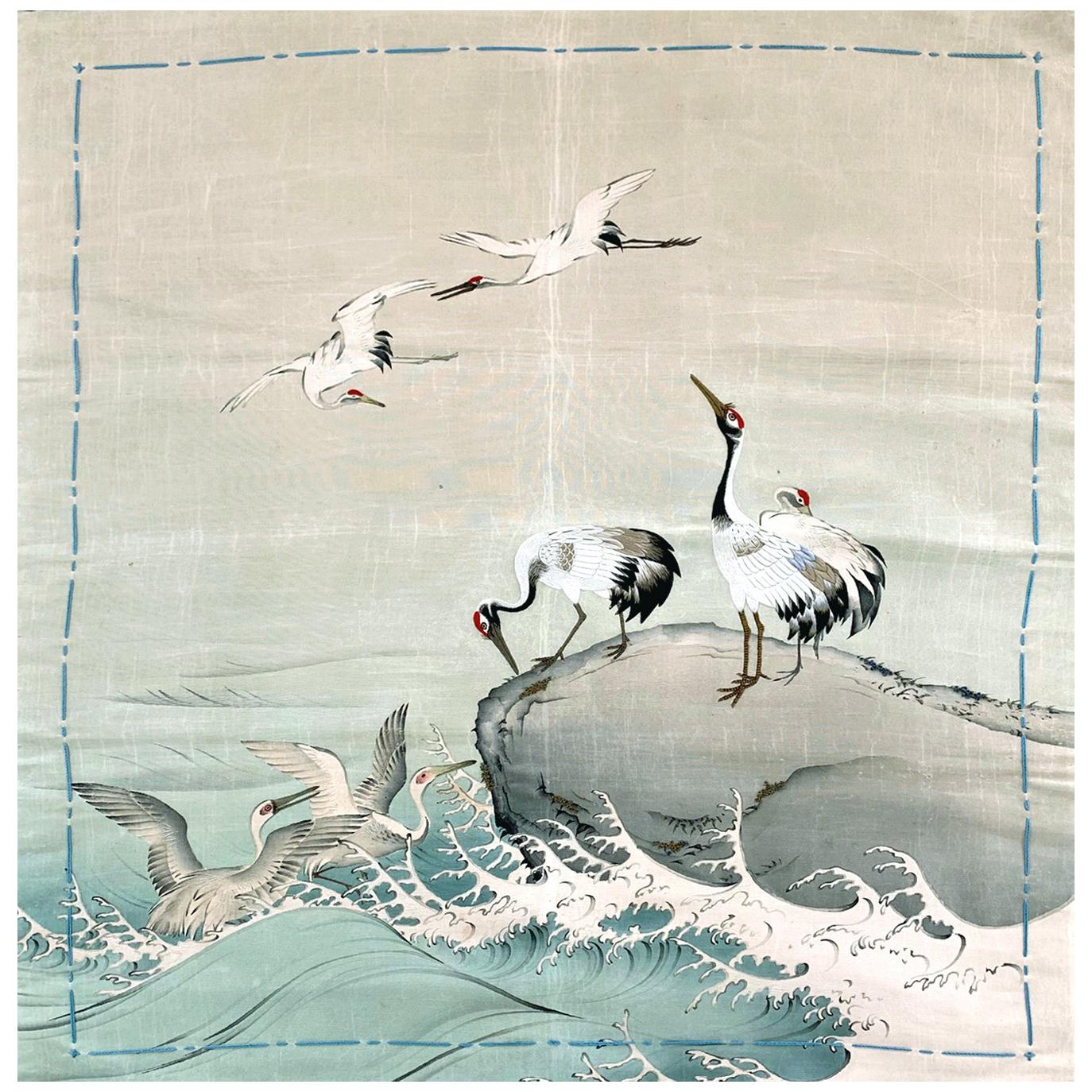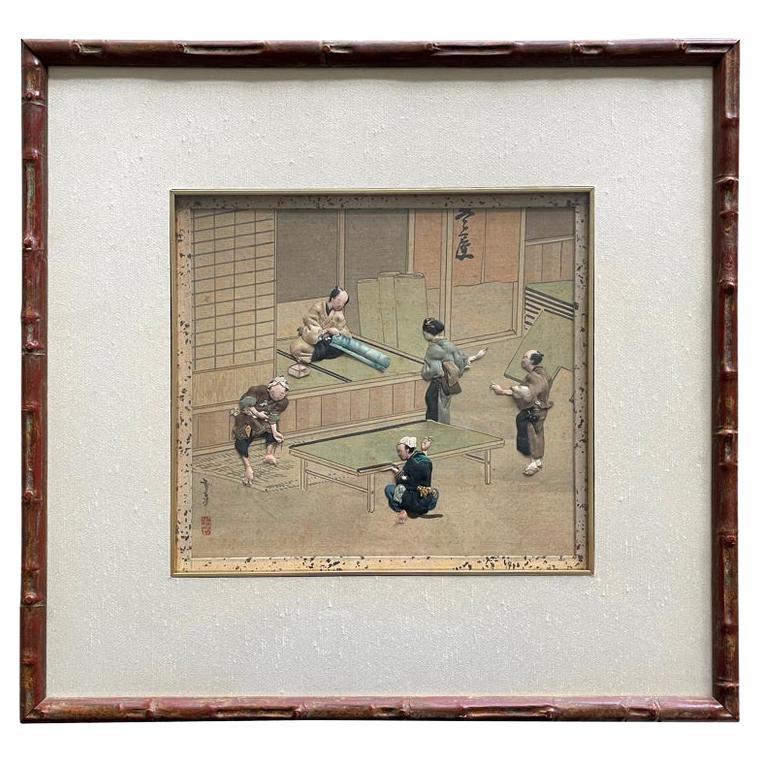Items Similar to Collection of Five Japanese Oshi-E Textile Art Panels Meiji Period
Want more images or videos?
Request additional images or videos from the seller
1 of 21
Collection of Five Japanese Oshi-E Textile Art Panels Meiji Period
About the Item
On offer is a set of five Japanese textile art panels called Oshi-E circa Meiji Period (1868-1912). This usual set of panels depict various aspects of daily life in Edo time with beautiful details. Some of these panels are snapshots of the buzzling commercial activities at the marketplace, providing insight into the signages, architecture, costumes and how people interacted within a historical and pictorial context. Other panels depict daily leisure activities such as lounging in the park or visiting friends. The realistic rendering and attention to details are not short of "photographic" quality. From the signage of the shops to the motions and attires of the individual characters, from the hairstyle, small ornaments, down to the facial expression, were all recorded in great details. Each panel was signed with the artist's name Yukihana in Kanji with a red seal.
These panels are unframed and await your custom touch (framing with inner gilt spacer and mat costs about 250-500 depending on the material chosen, see a framed example in the last picture of a single framed panel we have for sale). We offer them for sale individually, but it will be great for a collector to consider the whole set so that they can stay together.
The Oshi-E (also known as kiritori zaiku) is a type of ornamental textile art dated back to the Muromachi period (1392-1573). It started among the elite aristocratic women in Kyoto before spreading wider in the Japanese society. Throughout Edo and Meiji period, Oshi-E were sometimes used to make offerings to the altars in the temple and in the late 19th century, it was exported to the west along with the other embroidery textile art. Oshi-E was made by using silk wadding to create a relief design. Various silk fabric swaps and sometimes wires and tassels, often recycled from older kimonos among the other pieces, were used to create different desired effects. Much detail was focused on the elaborate dresses, head wears, faces, and plants in the setting. Ink and watercolors were used to facilitate the details of the design such as the background painting and the facial detailing. The work was time-consuming and in Meiji period, it was considered as a feminine accomplishment along with ikebana, embroidery and tea ceremony.
According to the book: Threads of silk and gold: ornamental textile from Meiji Japan published by Ashmolean museum of art and archaeology University of Oxford, few examples survived to this day.
Reference: Threads of Silk and Gold: Ornamental Textile from Meiji Japan published by Ashmolean museum of art and archaeology University of Oxford. Page 178.
- Dimensions:Height: 10.5 in (26.67 cm)Width: 12 in (30.48 cm)Depth: 0.25 in (6.35 mm)
- Style:Japonisme (Of the Period)
- Materials and Techniques:
- Place of Origin:
- Period:
- Date of Manufacture:1880-1900s
- Condition:Wear consistent with age and use. General minor surface wear consistent with age. Some panels show a bit more foxing. Wear on the raised edges that will not be visible once framed.
- Seller Location:Atlanta, GA
- Reference Number:1stDibs: LU945029234272
About the Seller
5.0
Platinum Seller
These expertly vetted sellers are 1stDibs' most experienced sellers and are rated highest by our customers.
Established in 2006
1stDibs seller since 2010
477 sales on 1stDibs
Typical response time: <1 hour
- ShippingRetrieving quote...Ships From: Atlanta, GA
- Return PolicyA return for this item may be initiated within 2 days of delivery.
More From This SellerView All
- Rare Historical Set Japanese Oshi-E Textile Art Panels Meiji PeriodLocated in Atlanta, GAOn offer here is a rare set of eleven Japanese textile art with painting panels called Oshi-E circa Meiji Period (1868-1912). This unusual set of panels depict various composition of...Category
Antique Late 19th Century Japanese Meiji Textiles
MaterialsSilk, Fabric, Paper
- Japanese Antique Fukusa Textile Art Meiji PeriodLocated in Atlanta, GAA Japanese silk Fukusa panel circa late 19th-early 20th century of Meiji Period. The front was beautifully decorated with Yuzen-zome, a labor intensive resist-dye technique invested ...Category
Early 20th Century Japanese Japonisme Textiles
MaterialsSilk, Beads
- Japanese Antique Fukusa Textile Art Meiji PeriodLocated in Atlanta, GAA Japanese silk Fukusa panel circa late 19th-early 20th century of Meiji Period. The front was beautifully decorated with Yuzen-zome, a labor intensive resist-dye technique invested by an artist monk Miyazaki Yuzensai (1654 -1736) of Edo period. The front cover likely depicts a scene from the Tale of Genji, showing a nobleman and his servant pays a visit to a lady in a fenced thatch-roof house under a high peak. The details of blossom trees and pines, as well as the characters, and scenery with a gradual color are astounding. It is telling that the Yuzen dying was used such an mastery. The piece has a red silk backing and still retains two red tassels on the lower corners as well as decorative stitches along the edges. There is a patched design on the back likely a Mon symbol (family crest). Fukusa is a traditional Japanese textile...Category
Early 20th Century Japanese Japonisme Textiles
MaterialsSilk
- Japanese Antique Fusuka Textile Art Meiji PeriodLocated in Atlanta, GAA Japanese silk Fukusa panel circa late 19th-early 20th century of Meiji Period. The front was beautifully decorated with Yuzen-zome, a labor intensive resist-dye technique invested by an artist monk Miyazaki Yuzensai (1654 -1736) of Edo period. The auspicious composition features a group of red-crown cranes, the symbol of longevity. Three of them perch on the rock by the ocean (East Sea) an two of them are in flight. Additionally, two egrets frolic in the wave. Yuzen dying was used extensively to showcase the amazing details such as the waves and the gradual coloring effect. Embroidery was used sparsely to highlight areas such as the legs of the crane to render it more dimensional details. The piece has a red silk backing and still retains four blue tassels on corners as well as decorative stitches along the edges. Fukusa is a traditional Japanese textile...Category
Early 20th Century Japanese Japonisme Textiles
MaterialsBrocade, Silk
- Framed Japanese Oshi-E Textile Art Meiji Period from a Rare Large SetLocated in Atlanta, GAOn offer is the last one of the set of seven framed Japanese textile art called Oshi-E circa Meiji Period (1868-1912). This rare set consists ...Category
Antique 1890s Japanese Japonisme Textiles
MaterialsSilk, Giltwood
- Framed Japanese Fukusa Textile Art Meiji PeriodLocated in Atlanta, GAA Japanese Fukusa textile panel circa late 19th-early 20th century of Meiji Period. On the woven brocade background with gold thread forming clouds and...Category
Antique Late 19th Century Japanese Japonisme Textiles
MaterialsSilk, Giltwood
You May Also Like
- Five Clawed Dragon Chinese Silk and Metallic Thread Embroidered TextileLocated in Ferrara, ITIn this amazing textile, dragons with five claws are flying among the clouds and seem to be protecting a very special diamond. In the past, the dragon was a symbol of power and luck....Category
Antique Late 19th Century Chinese Other Textiles
MaterialsMetallic Thread
- Pair of 19th Century Chinese Textile Qing Dynasty Embroidered Sleeve PanelsLocated in London, GBA Pair Of Chinese Embroidered Sleeve Panels. China, 19th Century, Qing Dynasty. Antique textile ff rectangular form, with a central seam, one decora...Category
Antique 19th Century Chinese Qing Textiles
MaterialsSilk
- Vintage Kimono Silk Brocade Japanese Ceremonial 1970Located in North Hollywood, CAA vintage Mid-Century ivory color silk brocade collectable Japanese ceremonial kimono. One of a kind. Fabulous museum quality ceremonial kimono in pure silk with intricate detailed h...Category
20th Century Japanese Japonisme Textiles
MaterialsSilk
- Late Meiji Period Sleeping Kimono / Yogi, JapanLocated in Point Richmond, CALate Meiji Period sleeping Kimono / Yogi, Japan Yogi are a type of oversized sleeping kimono traditionally used in Japan. This kimono would have b...Category
Early 20th Century Japanese Tribal Textiles
MaterialsCotton
- Vintage Japanese Ceremonial Kimono Gold Brocade with Flying CranesLocated in North Hollywood, CAA vintage Mid-Century ivory color silk brocade collectable Japanese ceremonial kimono. One of a kind hand crafted. Fabulous museum quality ceremonial piece in pure silk with intricat...Category
20th Century Japanese Japonisme Textiles
MaterialsSilk
- Vintage Kimono Red Silk Brocade Japanese Ceremonial Wedding DressLocated in North Hollywood, CAA vintage midcentury red color silk brocade collectable Japanese ceremonial wedding kimono. One of a kind handcrafted . Fabulous museum quality ceremonial piece in pure silk with ...Category
20th Century Japanese Japonisme Decorative Art
MaterialsSilk
Recently Viewed
View AllMore Ways To Browse
Framer Textile
Custom Textile
Small Textile
Textiles To Frame
Red Textile
Set Of Textiles
Antique Art Shop
Five Panel
Seal Collection
Textile Gold
Antique Textile Designs
Plant Textile
Antique Collectors And Period Furniture
Framed Fabric Textiles
Old Textiles
Antique Fabric Fabric Textiles
Antique Fabric Textiles
Antique Textiles Fabric Textiles





